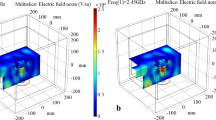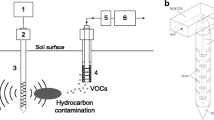Abstract
Microwave heating is one of the major treatment approaches for remediating contaminated soil, and the underlying thermal effects are worth studying. This study established a microwave reaction chamber model to simulate this heating process. The results show that the microwave power and frequency significantly influenced the electric field strength in the reaction chamber and the temperature distribution in the soil sample. The temperature distribution through numerical simulation was generally consistent with the experimental results of color-changing silica gel and infrared thermography, thereby verifying the reliability of the model simulation. In a microwave thermal effect experiment using diatomaceous soil, increasing the water content to 10% was found to increase the maximum temperature by 30 °C. The effective power and temperatures for microwave remediation differed according to the type of contaminated soil. The optimum removal rate for xylene-contaminated soil was achieved at a microwave power of 500 W, whereas that for nitrobenzene-contaminated soil required power of 750 W. Based on the contaminated soil degradation experiment, equipment for the continuous microwave treatment of contaminated soil was designed in simulation to verify the temperature at which the contaminated soil could be degraded. The research results provide a theoretical basis for the microwave remediation of contaminated soil.
Graphical abstract












Similar content being viewed by others
Data Availability
The datasets generated during and/or analyzed during the current study are available from the corresponding author on reasonable request.
References
Ailinnei, J., Energy, R., & Corporation, L. (2017). Application of microwave technology in governance of typical solid waste pollution. Coal and Chemical Industry, 40(2), 5.
Barba, A. A., Acierno, D., & D’ Amore, M. (2012a). Use of microwaves for in-situ removal of pollutant compounds from solid matrices. Journal of Hazardous Materials, 207–208(Mar.15), 128–135.
Barba, A. A., Acierno, D., & D’Amore, M. (2012b). Use of microwaves for in-situ removal of pollutant compounds from solid matrices. Journal of Hazardous Materials, 207–208(6), 128–135.
Buttress, A. J., Binner, E., Yi, C., Palade, P., Robinson, J. P., & Kingman, S. W. (2016). Development and evaluation of a continuous microwave processing system for hydrocarbon removal from solids. Chemical Engineering Journal, 283, 215–222.
Careghini, A., Saponaro, S., Sezenna, E., Daghio, M., Franzetti, A., Gandolfi, I., & Bestetti, G. (2015). Lab-scale tests and numerical simulations for in situ treatment of polluted groundwater. Journal of Hazardous Materials, 287, 162–170.
Chen, F., Warning, A. D., Datta, A. K., & Xing, C. (2017). Susceptors in microwave cavity heating: Modeling and experimentation with a frozen pie. Journal of Food Engineering, 195, 191–205.
Fodah, A. E. M., Ghosal, M. K., & Behera, D. (2021). Microwave-assisted pyrolysis of agricultural residues: Current scenario, challenges, and future direction. International Journal of Environmental Science and Technology, (3), 1735–2630.
Hong, Y. D., Lin, B. Q., Li, H., Dai, H. M., Zhu, C. J., & Yao, H. (2016). Three-dimensional simulation of microwave heating coal sample with varying parameters. Applied Thermal Engineering, 93, 1145–1154.
Jing, L., Dong, Y., Dong, X., Hampshire, S., Li, Z., Zhu, Z., & Li, L. (2016). Feasible recycling of industrial waste coal fly ash for preparation of anorthite-cordierite based porous ceramic membrane supports with addition of dolomite. Journal of the European Ceramic Society, 36(4), 1059–1071.
Kawala, Z., & Atamańczuk, T. (1998). Microwave-enhanced thermal decontamination of soil. Environmental Science and Technology, 32(17), 2602–2607.
Klinbun, W., Rattanadecho, P., & Pakdee, W. (2011). Microwave heating of saturated packed bed using a rectangular waveguide (TE 10 mode): Influence of particle size, sample dimension, frequency, and placement inside the guide. International Journal of Heat & Mass Transfer, 54(9), 1763–1774.
Krouzek, J., Durdak, V., Hendrych, J., Masin, P., Sobek, J., & Spacek, P. (2018). Pilot scale applications of microwave heating for soil remediation. Chemical Engineering and Processing - Process Intensification, 130, 53–60.
Li, L. B. J. (2012). Modification of microwaved coal fly ash and its adsorption properties for Cr~(6+). Chinese Journal of Environmental Engineering, 6(9), 3275–3279.
Liu, P., Gao, S., Huang, W., Ren, J., & He, W. (2020). Hybrid zeolite imidazolate framework derived N-implanted carbon polyhedrons with tunable heterogeneous interfaces for strong wideband microwave attenuation. Carbon, 159, 83–93.
Liu, J., Zhao, L., Liu, Q., Li, J., Qiao, Z., Sun, P., & Yang, Y. (2021). A critical review on soil washing during soil remediation for heavy metals and organic pollutants. International Journal of Environmental Science and Technology, 3, 1735–2630.
Luo, H., Wang, H., Kong, L., Li, S., & Sun, Y. (2019). Insights into oil recovery, soil rehabilitation and low temperature behaviors of microwave-assisted petroleum-contaminated soil remediation. Journal of Hazardous Materials, 377, 341–348.
Mushtaq, F., Zahid, M., Bhatti, I. A., Nasir, S., & Hussain, T. (2019). Possible applications of coal fly ash in wastewater treatment. Journal of Environmental Management, 240, 27–46.
Namazi, A. B., Allen, D. G., & Jia, C. Q. (2015). Probing microwave heating of lignocellulosic biomasses. Journal of Analytical & Applied Pyrolysis, 112, 121–128.
Peng, Z., Hwang, J. Y., & Andriese, M. (2013). Design of double-layer ceramic absorbers for microwave heating. Ceramics International, 39(6), 6721–6725.
Petri, I., Pereira, M. S., Santos, J. D., Duarte, C. R., Ataíde, C., & Panisset, C. (2015). Microwave remediation of oil well drill cuttings. Journal of Petroleum Science and Engineering, 134, 23–29.
Pitchai, K., Chen, J., Birla, S., Gonzalez, R., Jones, D., & Subbiah, J. (2014). A microwave heat transfer model for a rotating multi-component meal in a domestic oven: Development and validation. Journal of Food Engineering, 128(128), 60–71.
Robinson, J. P., Kingman, S. W., Snape, C. E., Shang, H., Barranco, R., & Saeid, A. (2009). Separation of polyaromatic hydrocarbons from contaminated soils using microwave heating. Separation & Purification Technology, 69(3), 249–254.
Sadikoglu, H. O., & Ongen, A. (2016). Stabilization of galvanic sludge by microwave pre-treated pyrolysis. International Journal of Environmental Science and Technology, 13(2), 691–698.
Salema, A. A., & Afzal, M. T. (2015). Numerical simulation of heating behaviour in biomass bed and pellets under multimode microwave system. International Journal of Thermal Sciences, 91, 12–24.
Samanli, S. (2011). A comparison of the results obtained from grinding in a stirred media mill lignite coal samples treated with microwave and untreated samples. Fuel, 90(2), 659–664.
Santos, J. M., Petri, I. J., Mota, A. C. S., Morais, A. D. S., & Ataíde, C. H. (2018). Optimization of the batch decontamination process of drill cuttings by microwave heating. Journal of Petroleum Science & Engineering, 163, 349–358.
Sivagami, K., Padmanabhan, K., Joy, A. C., & Nambi, I. M. (2019). Microwave (MW) remediation of hydrocarbon contaminated soil using spent graphite – An approach for waste as a resource. Journal of Environmental Management, 230, 151–158.
Switzer, C., Pironi, P., Gerhard, J. I., Rein, G., & Torero, J. L. (2014). Volumetric scale-up of smouldering remediation of contaminated materials. Journal of Hazardous Materials, 268(3), 51–60.
Tyagi, V. K., & Lo, S. L. (2013). Microwave irradiation: A sustainable way for sludge treatment and resource recovery. Renewable & Sustainable Energy Reviews, 18, 288–305.
Xiao, J. L. Z., & Feng, J. (1984). Microwave dielectric properties of rocks and soils and their application in microwave remote sensing. Chinese Science Bulletin, 29(8), 1123–1123.
Xitao, L., & Gang, Y. (2006). Combined effect of microwave and activated carbon on the remediation of polychlorinated biphenyl-contaminated soil. Chemosphere, 63(2), 228–235.
Yang, B., Xue, N., Ding, Q., Vogt, R. D., Zhou, L., Li, F., Wu, G., Zhang, S., Zhou, D., & Liu, B. (2014). Polychlorinated biphenyls removal from contaminated soils using a transportable indirect thermal dryer unit: Implications for emissions. Chemosphere, 114(22), 84–92.
Zhifu, Q., Tong, C., Sihong, B., Mi, Y., Shengyong, L., Alfons, B., Jianhua, Y., Cora, B. U., & Xiaodong, L. (2014). Effect of temperature and particle size on the thermal desorption of PCBs from contaminated soil. Environmental Science & Pollution Research, 21(6), 4697–4704.
Acknowledgements
This work was supported by a National Natural Science Fund project (51104022) and a teacher team construction Top-notch Youth Project (municipal) (PXM2016 014222 000043).
Author information
Authors and Affiliations
Corresponding author
Ethics declarations
Conflict of Interest
The authors declare no competing interests.
Additional information
Publisher's Note
Springer Nature remains neutral with regard to jurisdictional claims in published maps and institutional affiliations.
Rights and permissions
About this article
Cite this article
Zhou, C., Zeng, W., Wang, S. et al. Thermal Effects of Microwaves in Contaminated Soil Remediation. Water Air Soil Pollut 233, 23 (2022). https://doi.org/10.1007/s11270-022-05497-w
Received:
Accepted:
Published:
DOI: https://doi.org/10.1007/s11270-022-05497-w




